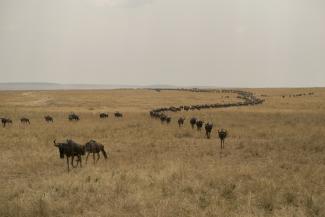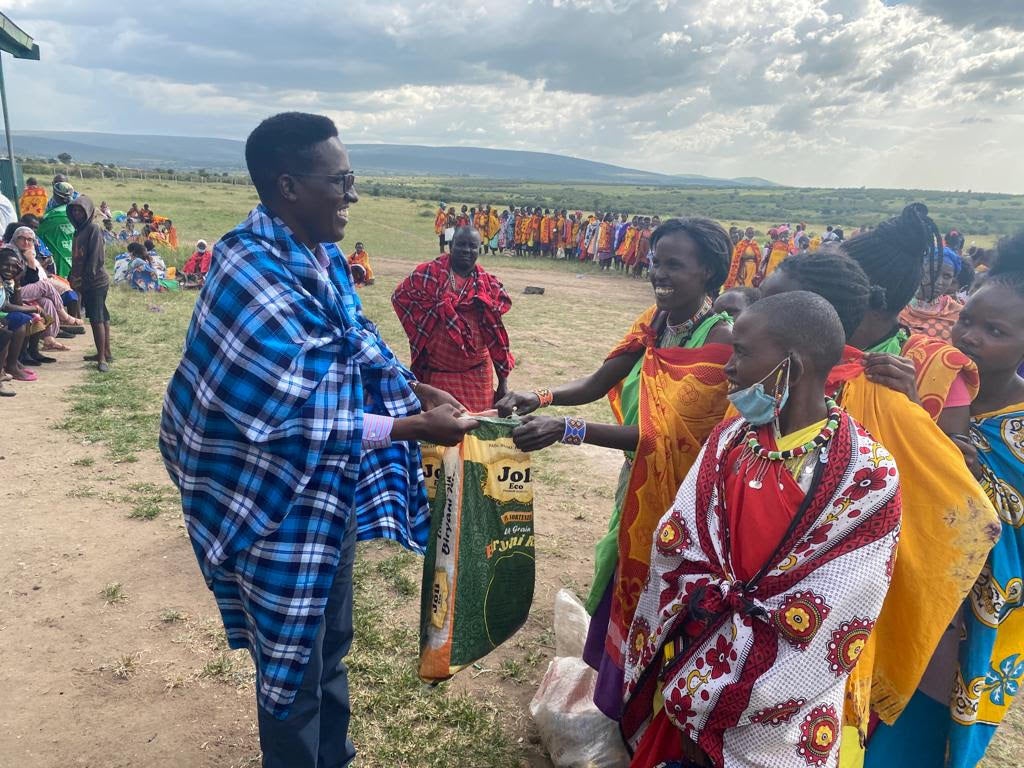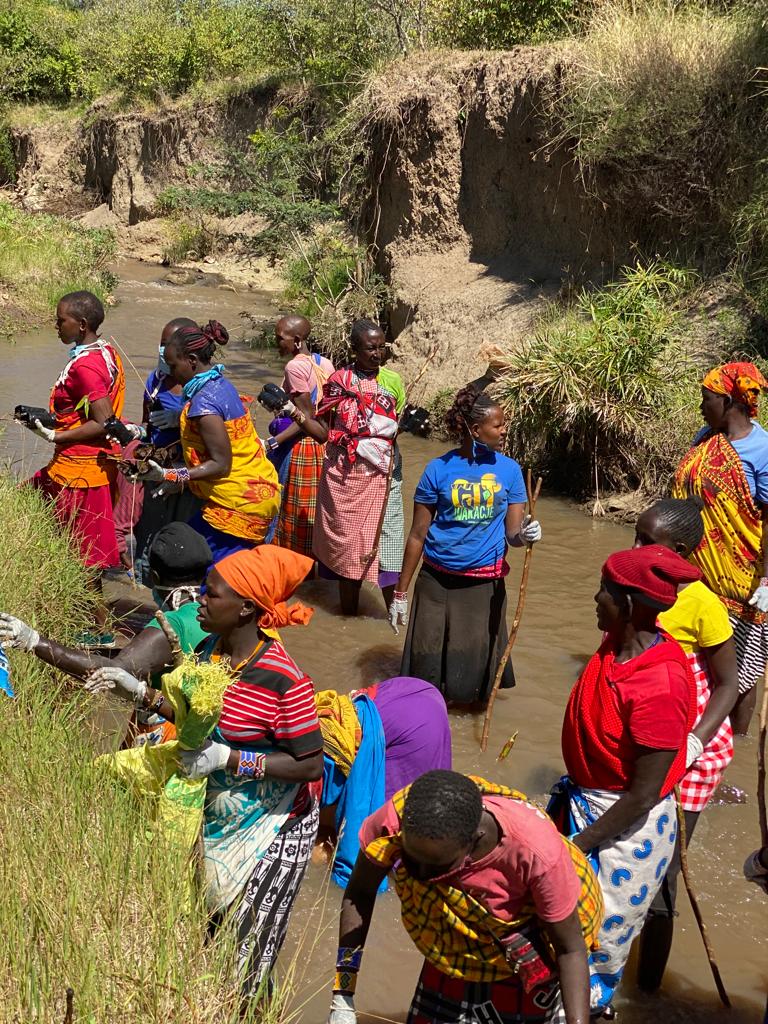
Nelson Ole Reiyia (Maasai) is Co-founder of the Nashulai Maasai Conservancy (NMC) based in the Maasai Mara in Southwestern Kenya. Nashulai is one of the first Indigenous-owned and run conservancies in East Africa. It challenges western colonial frameworks of land and resource management and conservation in the wake of threats of biodiversity loss, cultural disruption, poverty, and climate change.
Miriam Anne Frank is an applied anthropologist supporting Indigenous Peoples for over three decades. She works as an independent consultant to IPOs, NGOs, foundations, and intergovernmental and cultural institutions. She is an external lecturer for the Department for Social and Cultural Anthropology, University of Vienna, Austria. Miriam stayed at one of Nashulai’s conservancy camps and recently spoke with Nelson about his work.

Nelson Ole Reiyia (Maasai).
Miriam Anne Frank: How is Nashulai Maasai Conservancy implementing an Indigenous-led model of conservation?
Nelson Ole Reiyia: NMC was established in 2016 by the members of the community, who are also the land owning families in that area. Before that was established, there were fences erected all over the place and there was land commodification, fragmentation, and laws disrupting the cultural cycles and social cohesion of the community. The community decided to act to create a unique model of conservation inspired by Indigenous Traditional Knowledge. It’s a conservancy whose main ethos is coexistence. This means that people, wildlife, and livestock continue to share the land so the community did not have to lose their land for the sake of creating a national park.
The size at the beginning was around 5,000–6,000 acres of a critical triangle which borders the Maasai Mara National Reserve, an ancient wildlife corridor. Over time, Nashulai has expanded by adding another 10,000 acres in an area called Nashulai East. Currently, Nashulai is comprised of two conservancies, which are jointly run. The main Nashulai which borders the Mara has 124 land owning families, and Nashulai East has 75 land owning families. Nashulai is community-led, so people remain on the land to sustain their livelihoods and their culture. It’s a model that espouses balance, harmony, and coexistence.
It is not run by the government or by outside tourism; it is run by the local people. We have a distinguished team of Elders who are leading rotational grazing within the conservancy using the old ways of the Maasai. The main difference between Nashulai and other protected areas is the fact that the people remain on their land. They continue to relate to the land, they continue to enjoy the memory of their land, they continue to access it for cultural and ceremonial reasons, for medicinal uses, for grazing, while at the same time protecting wildlife. The typical protected area would remove the people and lease the land for tourism purposes.
MAF: How is Nashulai Maasai Conservancy organized?
NOR: Nashulai Maasai Conservancy has a management company that has a board of directors. Then we have a Council of Elders who are the leaders on the ground. Women and youth are fully involved. We have women leaders in the Council of Elders because we value gender equity. We also have women rangers who are part of the team and several women that are in jobs that are offered through the conservancy. The youth are also involved, working as game rangers.
MAF: What is the role of Traditional Knowledge and your relationship with your ecosystem?
NOR: We have an age-old tradition of nomadic pastoralism. Our forefathers, even our own fathers and ourselves, used to move our livestock around to different areas to ensure balance and to conform with the weather patterns and water cycles to avoid overgrazing and to ensure that the management of the rangeland is taken care of. In Nashulai, we have basically returned to that old way of knowing. Our grazing committee, which is part of our Council of Elders, oversees that aspect. We also have our women engaged in water restoration because they are the primary water users. We continue to identify all the plants within the conservancy and we have a herbarium. We recognize the trees and plants and their importance in the ecosystem. Also, we monitor the weather patterns using our Traditional Knowledge. So, in as much as we use science, which we do, this goes hand in hand with our Traditional Knowledge systems.

Maasai women lead a river restoration project.
MAF: How is Nashulai working to reclaim your ancestral territory?
NOR: We are having a new concept to scale up the conservancy we are calling “conservation beyond the conservancies.” We are going beyond the territories of Nashulai to bring more and more areas under the Nashulai conservation model. To that effect, we have created Nashulai Conservation Association so that more communities who are outside the main protected areas and tourism-based conservancies can join the Nashulai model.
During the COVID-19 pandemic there was a crisis. There was no food and people were starving. Nashulai organized a feeding program for 28,000 people weekly, so we gained a lot of social trust among the different communities. Now we are using that social capital to approach the other Tribes to join in Nashulai’s model. Recently, 200 leaders joined from different segments of the conservancy’s communities—spiritual leaders, political leaders, the youth—they all signed Nashulai’s 2023 Declaration, “The Maasai Response to the Climate Crisis.” And in that response they committed almost two million acres of their ancestral lands to the Nashulai Conservancy model.
MAF: What are some of your other recent successes?
NOR: For one, we have doubled our conservancy in size, so now we have the main Nashulai and Nashulai East. Secondly, we launched a feeding program to combat starvation during COVID; no one else did that. Thirdly, we have managed to run a concept of balance and harmony where people and wildlife live in perfect balance and harmony without conflict. No one else is doing that.
Our other success story is that without depending on tourism like all the other game parks, game reserves, and conservancies, we have been able to sustain the conservancy for eight years now. We believe that the moment that tourism and hotels come in, the model will change drastically. We have established an educational institute within the conservancy, the Nashulai Training Center, which has a vocational unit to train the youth from the community and build their capacity not only to find jobs in the multibillion dollar tourism industry in the Mara, but to become their own employers. We are also training other community leaders about Indigenous-led conservation, Indigenous land rights, and climate change adaptation and mitigation.
MAF: What are you hoping to achieve next?
NOR: Our goal is sustainability. This is a dream and a vision whose time has come. It’s an inspiration to many other communities not only in Maasai land, but beyond. This concept of Indigenous-led conservation is one we need to sustain financially. We also need to continue earning the trust of the communities, so financial sustainability is very important. But this has to be done carefully in a way that sustains the people and the community on the land.
The other goal is to develop our concept of a Stories Cafe. We have always had this idea to create a Traditional Knowledge center where the Elders will transfer their ancestral knowledge to the younger generation. The knowledge of their culture, cosmology, and ethnobotany of the environment can be used by the younger generation. We started building Netii Apa (once long, long ago), and also Netii Taata, which means, “it used to be there and now it is still there.” Another goal is sustainable tourism, as that will enable the community living around the conservancy to benefit from it. We have a goal to expand the capacity of our college and we are collaborating with international universities.
It is our vision that the conservancy will become not just a place for tourism, but also an educational institute where university students come for research and anthropologists come to learn about the Maasai culture. And we want to expand our “conservation beyond conservancies” model through the Nashulai Association. We are talking to more and more communities to replicate this concept so that we can create impact at scale.
To learn more about Nashulai Maasai Conservancy and to support their vision, visit: www.nashulai.com.
Top photo: Open wildlife corridor.
All photos courtesy of Nashulai Maasai Conservancy.
